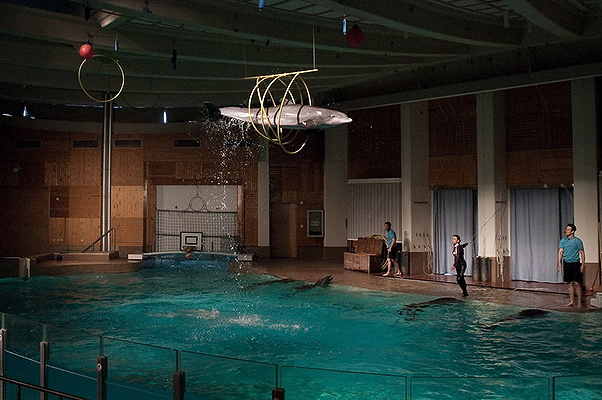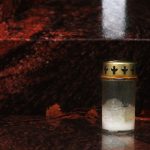
A dolphin performing circus tricks at the Särkänniemi Dolphinarium in 2009. Picture: Anssi Koskinen/Flickr
On Monday afternoon, pictures of Delfi, Veera, Eevertti and Leevi started surfacing in the media from the Attica Zoological Park in Athens, Greece.
After bringing millions of euros into the coffer of Särkänniemi amusement park in Tampere for three decades, the dolphins were now swimming in an unfamiliar tank and climate. They had been transported to Attica in secrecy on Saturday night. Well . . . in attempted secrecy.
Särkänniemi Dolphinarium had decided to stop the theatrical dolphin performances last autumn. The shows had stopped making a profit. People’s attitudes had changed over the years, and the voice of the animal rights organizations had been heard. Last October, the dolphinarium was closed. The bottlenose dolphins Delfi, Veera, Eevertti and Leevi, however, continued to live in Särkänniemi waiting for a new tank that could be assigned as their new home.
The animal rights organization Oikeutta eläimille (Justice for Animals) was hinted of when the transfer of the dolphins would take place, and on Saturday night at Särkänniemi, the organization was ready to take snapshots with their cellphones and cameras for their Facebook page. After the first pictures appeared on social media, the working press hurriedly pulled on their pants and hurled to the scene.

A dolphin splashes while it’s being loaded into a container on Saturday night at the Särkänniemi amusement park. Picture: A screen capture of Oikeutta eläimille organization’s Facebook page
People caught pictures of men transferring the dolphins into containers and trucks, while they tried to conceal the action behind big tarpaulins. There were plenty of police at the scene, too, to make sure that the transfer to the airport goes as smoothly as a flick of a dolphin’s tail. Random observers appeared as well.
Since Sunday, the secrecy has been rubbing the media raw. An acquaintance of mine with a long history in media business reminded me of the fact that when someone tries to hide something from the press, the press gets pissed. When angry, the average newspaperman becomes critical. The trust is lost.
On Sunday, Monday and Tuesday, Miika Seppälä, CEO of Särkänniemi amusement park, has been explaining the reasoning behind the secrecy. At first, he said to Helsingin Sanomat that the plan to move the dolphins behind the backs of the media was an agreement between the police and Särkänniemi. After the police said that the amusement park had made the decision, Seppälä, like any other high-powered guy in hot water, did what according to the communication experts is best: apologized. “I would act differently now, if I could,” he said while referring to the secrecy.
Seppälä said that he made the decision by himself because he wanted to focus the attention on the safety of the animals. “I should have however informed about the subject quickly and openly.” “I wanted to guarantee a work in peace and the safety of the operation. I still made a mistake when I didn’t confirm this to the media after the situation became public.”
Maybe there was a real risk that someone would try to obstruct the transport of the dolphins to Attica. The zoo has, after all, been bashed by animal rights organizations of lacking in providing proper shade from the harsh Greek sunlight in the tanks where the zoo’s four male dolphins already splash. The activists have also criticized the tanks of being too shallow. The Greek Green Party has demanded to stop the dolphin shows and closing the dolphinarium; the aquarium had been constructed without permission and the dolphins had been imported there without permission, too. Attica has reported five dolphin deaths between 2010 and 2015.
Two of the oldest Särkänniemi dolphins, Veera and Delfi, were captured in the Gulf of Mexico in 1984. Both were born around 1978-1980. Leevi was born in Särkänniemi in 1993 and Eevertti in 1996. Särkänniemi Dolphinarium started operating in 1985.
Because the dolphins have lived in captivity, they are dependent on human care. They would not survive in the sea. To let them free would be like leaving a cat to the cottage after the summer. “They are used to being taken care of and will not necessarily find food in nature,” said Essi Keskinen, a marine biologist. “Those born in captivity – well, all of them have been living in captivity for really long – have been used to being fed at a certain time. They don’t necessarily know how to find living food.” In some ways, the dolphins born in the tank are like the kid born in the shed in the film Room, where everything he sees from the tiny window of the roof is magic.
In Attica, after an adjustment period, the dolphins will participate in shows for “educational purposes.” Greece has banned dolphin shows in zoos but the law has been circumvented by calling them “educational.” Dolphinariums, however, provide little or no educational value. “Just think about taking a child to a marine park. This is not an educational experience because the child doesn’t see or understand what these animals are really about. Jumping and splashing on command or catching a fish from the hand of a trainer during a performance is just stereotyped, clown-esque behavior that shows little if anything of these animals’ everyday life,” said Maddalena Bearzi, president and co-founder of the Ocean Conservation Society. Bearzi has co-authored the book Beautiful Minds: The Parallel Lives of Great Apes and Dolphins and studied the lives of marine mammals for over twenty-five years. “Deprived of their natural space and social structures, dolphins change. Captive dolphins have nothing in common with those I have come to know in the wild,” she said.
Bearzi and other experts also stress the importance of acknowledging the cognitive abilities of the dolphins. Dolphins possess a high EQ due to their unusually large brain-to-body-size ratios. “This brain has allowed dolphins to develop complex and fluid societies in which they can flourish against the backdrop of a challenging, three-dimensional liquid environment,” Bearzi said. “Only in a few species like dolphins, great apes, and humans, do we find brain complexity, social complexity, and ecological complexity closely linked.”
So why did Särkänniemi transfer the dolphins to Attica in the first place? Were there not any other options? Killing them was obviously not an option. That would be like putting an intelligent innocent sentient being into an electric chair.
The destination was decided by the European Association of Zoos and Aquaria (Eaza), an organization for the European zoo and aquarium community, that regulates the operation of zoos and dolphinariums. Because Särkänniemi is part of Eaza, their recommendation, in this case, Attica, is an order to follow. Inside the organization, different species have their own committees in the European Endangered Species Programme EEP.
According to David Williams-Mitchell, the head of communications at Eaza, the committee wanted to transfer the dolphins from aquaria to aquaria within Europe. “Attica fulfills all the criteria, and that’s why the committee decided to recommend that these four dolphins will move there,” he said. Williams-Mitchell denies the critic of animal rights organizations.
If the animal activists would have had the right to decide, the best place for Leevi, Delfi, Veera and Eevertti would have been an oceanside dolphin sanctuary somewhere in Europe. There are, however, plans to build one somewhere in North America by 2020, but concrete plans to build one in Europe does not exist of yet. (An organization has been scouting locations in Italy to build a dolphin care and protection center, though.) Oikeutta eläimille suggested that instead of shipping the dolphins to Attica, Särkänniemi should have invested the money to speed up the development of a dolphin sanctuary in Europe. “After decades of earning money with the benefit of these dolphins, Särkänniemi could have carried their responsibility. Instead, Särkänniemi decided to transfer Veera, Delfi, Eevertti and Leevi to another dolphinarium – one with a bad reputation . . . and decided to build an indoor playground to replace the dolphinarium and to invest millions to rides in the amusement park instead of financially supporting the building of a protection center,” the organization said on Facebook.

Delfi, Veera and Eevertti swimming in the pool at Attica Zoological Park on Monday August 29 in Athens suburb of Spata, Greece. Picture: Attica Zoological Park
In a way, arguing about whether Attica is the right place for the dolphins may be irrelevant at this point. The time for dolphinariums seems to have passed. People’s interest in watching animals in captivity has diminished after becoming more aware of animal behavior and mind.
Dolphins should splash free in the ocean, where they can swim 160 kilometers in a day and dive into the depth of 60 meters. “There is about as much educational benefit to be gained in studying dolphins in captivity as there would be studying mankind by only observing prisoners held in solitary confinement,” said Jacques Cousteau, the author and filmmaker, one of the most famous researchers of sea life.
Even Jenni Haukio, the spouse of the Finnish President Sauli Niinistö, took a stand on the life of Delfi, Veera, Eevertti and Leevi. “When animals like these were transferred to a concrete tank, which compared with their natural territory is the size of a fishbowl, one can’t think of the course of events in any other way than blind injustice,” Haukio said in a column for Seura magazine.
I agree with Mrs. Haukio. For 100 percent.













